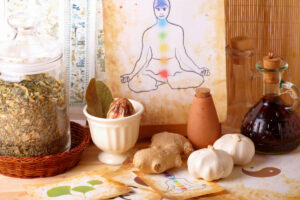Back
Understanding Burnout: Stages, Signs, and Solutions
11/21/2023 | Written by Kate Tant
Conscious Healthy Living

We live in a world filled with modern technology and conveniences. Life should be easy, but the demands of a fast-paced lifestyle quickly take their toll. We strive to find balance amid work-related stress, tension at home, or the worry of caring for our loved ones. Understanding burnout, its signs and solutions is critical before it threatens our health and well-being.
For many, burnout is an all too familiar companion. It’s a silent antagonist that slowly invades and envelops you like a dark fog until you are depleted and exhausted. Before combating this foe, you must understand burnout and its stages and signs. Once you know what to look for, you can implement holistic solutions to burnout. Keep reading to discover the unmistakable signs of burnout and how to transform your life through meditation, nature, and the power of herbs.
Work Burnout
Work burnout casts a shadow over many working professionals in their pursuit of growth and success. Mounting pressure to meet strict deadlines, multitasking to manage a growing workload, and navigating workplace dynamics lead to diminished productivity and emotional fatigue. Recognizing the signs of job burnout early on enables you to implement preventative measures before it’s too late.
Work From Home Burnout
The shift from office to remote work over the past few years brings additional challenges and introduces a different type of burnout. Suddenly, the lines between work and home life are blurred, creating work-from-home burnout. It’s critical to place boundaries around remote work responsibilities so they don’t infringe on personal time.

Parent Burnout
While being a parent is extremely rewarding, caring for children, running a household, and providing for the family can be overwhelming. Many couples experience parent burnout when balancing these responsibilities. In 2022, the Bureau of Labor Statistics reported that in 48.9 percent of married-couple families, both parents were employed. This means that a large percentage of the workforce could face parent burnout. Effective coping strategies are essential for the parents and the children’s contentment and fulfillment.
Caregiver Burnout
It’s estimated that over 69 million people in the United States provide care to disabled, chronically ill, or elderly family members or friends. Women around age 49 comprise the largest share of adult children caring for aging parents. With so many people caring for others, it’s no wonder the emotional toll of caring for loved ones leads to caregiver burnout. Caregivers must navigate this demanding role cautiously, preserving their health and well-being.
Compassion Fatigue Versus Burnout
While compassion fatigue and burnout share similarities, they are very different. Compassion fatigue occurs when you are weary and exhausted from caring for others. On the other hand, burnout is related to workplace stress. If caught and managed early, compassion fatigue has a quicker recovery time.
5 Stages of Burnout
Whether you are suffering from work, parent, or caregiver burnout, it doesn’t happen all at once. Let’s explore the five stages of burnout you might encounter.
1. Honeymoon Phase
This is the initial stage where you may experience a heightened enthusiasm for your work or the care you provide. In the honeymoon phase, any stress you experience is often overshadowed by the excitement of your circumstances.
2. Onset of Stress Phase
You may encounter subtle hints of exhaustion, irritability, or negative feelings as your job or home life demands increase. These signs of burnout creep in slowly, and you may not recognize their toll on your health.
3. Chronic Stress Phase
When you reach the chronic stress phase, burnout becomes persistent. You may try to cope with the mounting stress but soon feel helpless against the pressure. Your physical and mental well-being is compromised even further, leading you to full-on burnout.
4. Burnout Phase
The burnout phase is the tipping point. You feel completely depleted, and your ability to cope with stressors quickly diminishes. You are exhausted, irritable, and emotionally detached. You’ve hit the wall and don’t know how to bounce back.
5. Habitual Burnout Phase
Once you reach the habitual burnout phase, it feels like a slow burn that never subsides. You are trapped in the burnout cycle with little hope of breaking free. Feelings of inadequacy and disillusionment persist, making it challenging to escape the stressful patterns you’ve created or allowed to continue.
Understanding the stages of burnout will help you recognize when you need to change your routine. If you catch stress and burnout in its early stages, you can implement positive changes and simple techniques to reduce stress.

Understanding Burnout: 7 Signs to Check For
Understanding burnout and its symptoms can be tricky. Paying attention and taking action if you experience any warning signs is vital. Even experiencing one or two of these symptoms can have a profoundly detrimental effect on your level of satisfaction with your life.
1. Exhaustion
Physical, mental, and emotional exhaustion that you just can’t shake, even when you get a full night’s rest, is a sign of burnout. It’s a persistent tiredness and a complete lack of energy that makes it hard to concentrate and focus. Burnout exhaustion infiltrates every aspect of your life and diminishes your ability to find joy and fulfillment.
2. Decreased Performance
When you lack the mental energy to focus, performance naturally decreases. If you find you’re not as productive as you used to be, it could mean you’re starting to burn out. Decreased performance impacts your ability to complete tasks efficiently and adds a sense of frustration and helplessness.
3. Increased Procrastination
As burnout sets in, routine tasks that were once manageable become overwhelming, leading to a lack of motivation, which turns into procrastination. Feelings of defeat and guilt often accompany procrastination. Procrastination is a double-edged sword. It hinders your progress and intensifies the stress of missing deadlines.
4. Emotional Detachment
Apathy, or the lack of motivation and goal-driven behavior, often appears during burnout. Where once you were excited about your job and creating a successful career, burnout crushes enthusiasm and replaces it with apathy.
5. Irritability and Negativity
Even mild-mannered, generally happy, and positive individuals can succumb to irritability and negativity when burnout becomes too much to handle. If you notice an increased cynicism towards work, relationships, or caregiving responsibilities, it could mean you’re getting burned out.
6. Physical Symptoms
Ultimately, the stress and exhaustion caused by burnout can lead to physical symptoms such as muscle tension, digestive issues, and decreased immune function. In Ayurveda, all ailments, whether physical or mental, are caused by the imbalance of the doshas. Physical symptoms serve as the body’s warning that it needs attention to correct the imbalance.
7. Lack of Sleep
Another symptom of burnout is difficulty falling asleep and staying asleep. Replaying the day on a never-ending loop in your mind, being unable to turn off the waterfall of thoughts, or the constant worry from caregiving responsibilities can make it hard to sleep. Disrupted sleep patterns exacerbate fatigue, which heightens the other burnout symptoms.
Burnout can be tricky to identify. You may not experience all of these symptoms at once — they tend to layer on little by little. Understanding the seven signs of burnout helps you recognize when to stop, take a break, and focus on your health and well-being by incorporating a few simple strategies.

3 Solutions for Burnout
If you feel burned out, you’re not alone. It seems that occupational burnout and stress are on the rise. Luckily, you can incorporate a few simple strategies into your daily or weekly routine to mitigate the symptoms of burnout.
1. Meditation
The centuries-old practice of meditation has become more popular than ever. In its basic form, meditation is simply sitting quietly, focusing on conscious breathing, and clearing the mind or reflecting on a thought or idea. If you’re ready to challenge yourself, Pranayama is an ancient breathing technique that explores various breathing techniques.
2. Nature Walks
Our connection to nature was never meant to be severed; it’s a timeless bond that has sustained humans through the ages. Today, navigating the complexities of life necessitates rekindling this bond. The therapeutic benefits of immersing yourself in nature are well known. The Japanese even have a practice called shinrin yoku, or forest bathing. It’s a practice of calmly walking amongst the trees while breathing deep and letting the quiet envelop you. Walking outdoors, breathing fresh air, and listening to nature provide a reprieve from the demands of daily life while allowing your soul to become intertwined with the natural world.
3. Herbal Wellness
Ayurvedic practitioners have known for centuries about the power of plants. The roots, leaves, flowers, bark, and seeds of a myriad of plants are used to provide support for the body, mind, and spirit. Whether you prefer tea, a supplement, or both, it’s essential to have organic herbal products ready and available for daily stress relief. For those times when it all feels like too much, reach for your Ashwagandha or Tulsi supplement for stress relief, Shatavari for hormonal balance, or swap your coffee for Tulsi Masala Chai tea or an evening wind down with Tulsi Honey Chamomile tea. Look to Mother Earth to calm frazzled nerves and rejuvenate your day.

Overcoming Burnout
Understanding burnout is more than just recognizing that it exists; it’s about proactively looking for the seven signs of burnout and addressing each of burnout’s five stages. When you navigate through daily stress holistically, you’ll find helpful, sustainable solutions that will provide you with the tools to avoid burnout.
You’ll become more resilient when you intentionally create a healthier, more balanced life. Embracing mindfulness through meditation, reconnecting with nature through an earthing practice, or incorporating a stress-relieving tea ritual, are a few ways to overcome burnout and reclaim your joyful life. Take the first step towards lifelong wellness by exploring the transformative organic herbal options at your fingertips. ORGANIC INDIA has a variety of stress support options for you to choose from.















 Kate Tant is a professional health and wellness writer with a strong passion for holistic wellness. Her writing covers topics from Ayurvedic herbs and practices to nontoxic living and intermittent fasting. Her conversational writing style resonates with readers who are looking for help and encouragement when it comes to finding natural solutions to their health.
Kate Tant is a professional health and wellness writer with a strong passion for holistic wellness. Her writing covers topics from Ayurvedic herbs and practices to nontoxic living and intermittent fasting. Her conversational writing style resonates with readers who are looking for help and encouragement when it comes to finding natural solutions to their health.